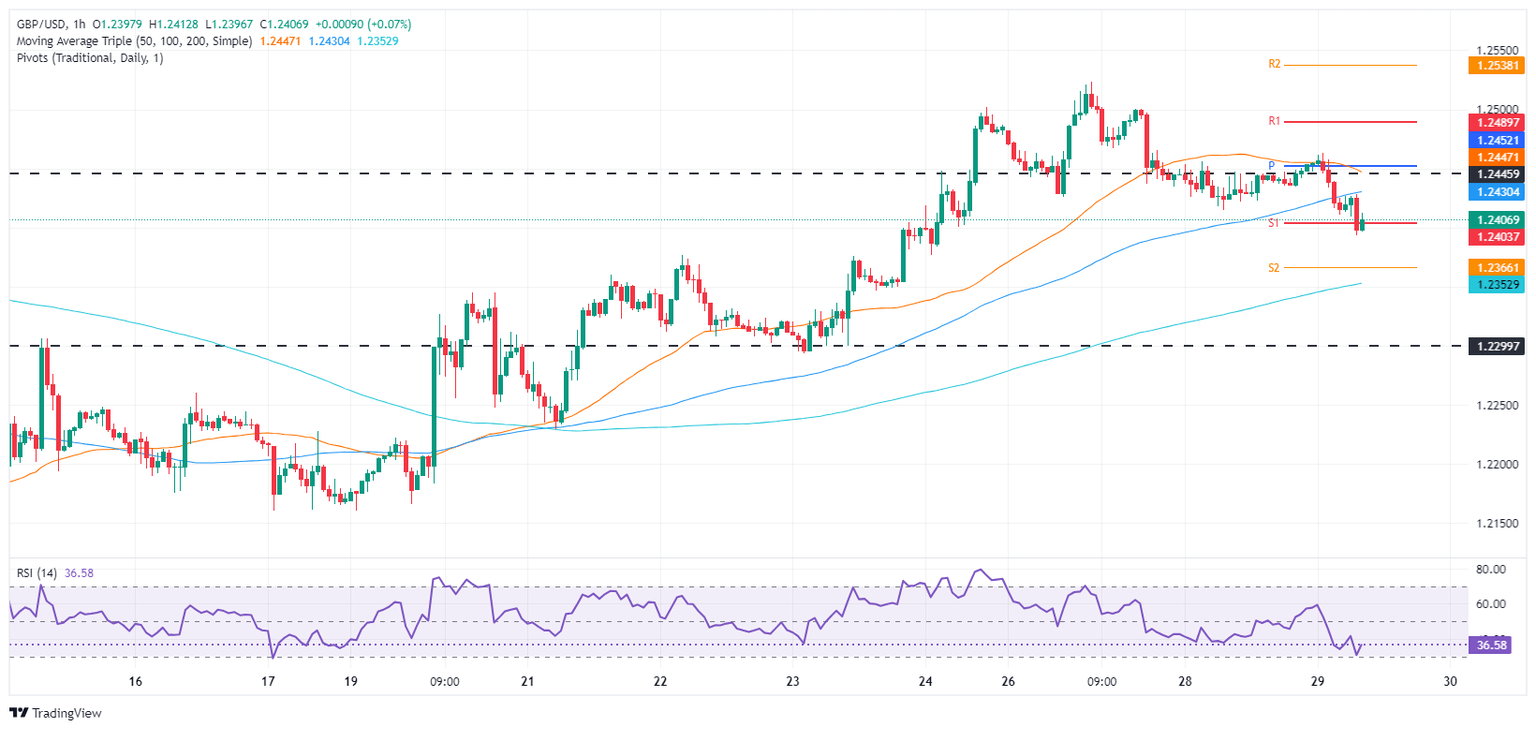GBP/USD weakens further as markets brace for Fed decision
- Sterling under pressure with scant domestic data; focus on upcoming Fed rate decision.
- Market sentiment favors Fed holding rates steady, with potential cuts later in the year.
- Investors await Fed Chair Powell's press conference for clues on future monetary policy.

The Pound Sterling extended its losses on Wednesday as the Greenback remains firm ahead of the US Federal Reserve’s monetary policy decision. An absent economic docket in the UK, except for Bank of England (BoE) Governor Andrew Bailey's TSC hearing, could move the markets ahead of the Fed. The GBP/USD trades at 1.2406, down 0.27%.
GBP/USD dips to 1.2406, losing 0.27% with investors on edge ahead of key Fed monetary policy
Risk appetite improved, but investors remain cautious ahead of the Fed. The odds that the US Central Bank may keep rates unchanged are 98%, though money markets estimate that Powell and Co. would cut rates twice, each 25 basis points (bps), the first in June and the second towards the end of the year.
Market players will be watching Fed Chair Jerome Powell's press conference. According to Brown Brothers Harriman (BBH), they expect Powell to emphasize again that the FOMC can be more cautious as the Fed considers further adjustments to its policy rate.
US economic data revealed on Tuesday showed that Core Durable Goods Orders improved slightly. Following its release, the Atlanta GDP Now model hinted that growth for the last quarter of 2024 might hit 3.2%, up from 3% before yesterday’s data.
In the meantime, financial markets recovered following Monday’s sell-off after DeepSeek revealed its latest AI model, which was cheaper than OpenAI’s or US models and required fewer computer resources.
Throughout the day, GBP/USD traders are waiting for the Fed’s decision and the Chair Powell press conference at 18:30 GMT.
GBP/USD Price Forecast: Technical outlook
From a daily chart perspective, the GBP/USD might extend its losses beneath 1.2400, after diving to a new three-day low of 1.2392. On further weakness, the pair could visit January 22 peak at 1.2375, ahead of 1.2350. Momentum turned bearish as seen by the Relative Strength Index (RSI).
In the short-term, the one hour chart indicates that the spot price fell below the 50 and 100 Simple Moving Averages (SMAs), finding acceptance below the latter which is at 1.2431. A drop below 1.2400 will expose the 200-SMA at 1.2353. Conversely, further upside is seen, once buyers lift GBP/USD above 1.2431 and 1.2446, with the latter being the 50-SMA.
Pound Sterling FAQs
The Pound Sterling (GBP) is the oldest currency in the world (886 AD) and the official currency of the United Kingdom. It is the fourth most traded unit for foreign exchange (FX) in the world, accounting for 12% of all transactions, averaging $630 billion a day, according to 2022 data. Its key trading pairs are GBP/USD, also known as ‘Cable’, which accounts for 11% of FX, GBP/JPY, or the ‘Dragon’ as it is known by traders (3%), and EUR/GBP (2%). The Pound Sterling is issued by the Bank of England (BoE).
The single most important factor influencing the value of the Pound Sterling is monetary policy decided by the Bank of England. The BoE bases its decisions on whether it has achieved its primary goal of “price stability” – a steady inflation rate of around 2%. Its primary tool for achieving this is the adjustment of interest rates. When inflation is too high, the BoE will try to rein it in by raising interest rates, making it more expensive for people and businesses to access credit. This is generally positive for GBP, as higher interest rates make the UK a more attractive place for global investors to park their money. When inflation falls too low it is a sign economic growth is slowing. In this scenario, the BoE will consider lowering interest rates to cheapen credit so businesses will borrow more to invest in growth-generating projects.
Data releases gauge the health of the economy and can impact the value of the Pound Sterling. Indicators such as GDP, Manufacturing and Services PMIs, and employment can all influence the direction of the GBP. A strong economy is good for Sterling. Not only does it attract more foreign investment but it may encourage the BoE to put up interest rates, which will directly strengthen GBP. Otherwise, if economic data is weak, the Pound Sterling is likely to fall.
Another significant data release for the Pound Sterling is the Trade Balance. This indicator measures the difference between what a country earns from its exports and what it spends on imports over a given period. If a country produces highly sought-after exports, its currency will benefit purely from the extra demand created from foreign buyers seeking to purchase these goods. Therefore, a positive net Trade Balance strengthens a currency and vice versa for a negative balance.
Author

Christian Borjon Valencia
FXStreet
Christian Borjon began his career as a retail trader in 2010, mainly focused on technical analysis and strategies around it. He started as a swing trader, as he used to work in another industry unrelated to the financial markets.

















